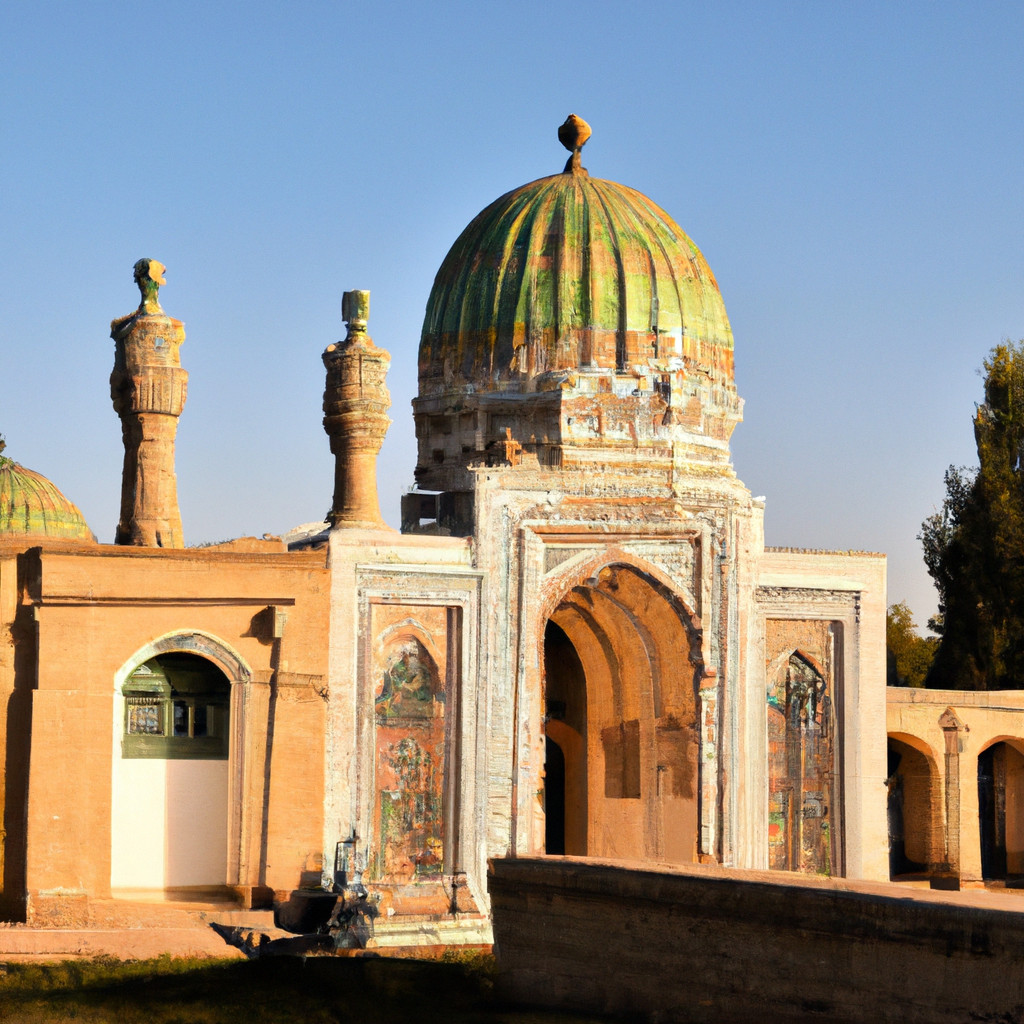Mausoleum of Sayed Nizamuddin in Lashkargah, is one of many fascinating sites that both foreign visitors and local tourists can explore while they visit Afghanistan and exploring Helmand Province. Drenched in centuries of history and culture, the Mausoleum offers a window into Afghanistan’s unique past. The mausoleum brims with deep historical significance, showcasing the architectural splendor of Afghan heritage, and it has played an invaluable role in shaping the country’s cultural and religious life across different eras.
Mausoleum of Sayed Nizamuddin Most Important Events
- The Construction: The Mausoleum of Sayed Nizamuddin was built in the early 15th century, an impactful event that still resonates today as it encapsulates the architectural beauty of that period and continues to serve as an icon of Afghan history.
- The Siege of 1842: In 1842, during the First Anglo-Afghan War, British forces sought refuge in Lashkargah, marking a critical juncture in the mausoleum’s history and moving it from the realm of religious significance into the world of military strategy.
- UNESCO Recognition: The international recognition of the Mausoleum as a UNESCO World Heritage site added significantly to the structure’s legacy, highlighting its global importance and putting it on the must-see list for tourists visiting Afghanistan.
History of Mausoleum of Sayed Nizamuddin in Lashkargah
The Mausoleum of Sayed Nizamuddin was erected in the early part of the 15th century. It is named after Sayed Ali Nizamuddin, a venerated spiritual mentor and mystic, who was highly esteemed for his wisdom and teachings in the region. The Mausoleum stands as a timeless monument to his life and teachings, which have fascinated countless individuals over the centuries.
In 1842, during the First Anglo-Afghan War, this same mausoleum provided sanctuary for British forces seeking refuge. The strategic location of Lashkargah made it a crucial stronghold. This event further entrenched the mausoleum’s reputation and importance in not only Afghan spiritual life but in its military and political history as well.
Fast forward to the present era, the Mausoleum has been recognized by UNESCO for its historical, religious, and architectural significance. It serves not only as a testament to the past but also to the resilience of the Afghan people and their capacity for preservation and reverence of their rich and diverse history.
Why It’s Important to Afghan History
The Mausoleum holds a vital place in Afghan history for numerous reasons. Sayed Nizamuddin, whom the structure commemorates, contributed significantly to the spiritual and intellectual growth of the region. His teachings have influenced numerous generations, and his wisdom continues to guide the thinking of many Afghans.
Furthermore, the Mausoleum bears witness to significant milestones in Afghan political history. Its strategic role during the First Anglo-Afghan War reflects how intertwined cultural and military histories often are. The preservation of such structures is therefore not only critical for maintaining a historical record but also to appreciate the complexities of Afghanistan’s evolution over time.
Why to Visit Mausoleum of Sayed Nizamuddin
Visiting the Mausoleum places you at the intersection of stunning architectural design and profound history. The intricate details of the building reveal an array of sophisticated design elements typical of the era, making it an architectural masterpiece. It is nestled within scenic surroundings, from where you can appreciate the natural beauty of the region.
At the Mausoleum, you can immerse yourself in the reflections of Afghanistan’s past, gain unique insights into the events that have shaped the country, and deepen your understanding of Afghan culture and philosophy. The structure allows you invaluable access to the country’s historic timeline and the impact of significant figures such as Sayed Nizamuddin.
- The architectural grandeur of the Mausoleum
- The serene natural surroundings
- The historical significance
- The cultural and spiritual connection
- The ancient craftsmanship showcasing the fusion of several design elements
The Mausoleum is located in Lashkargah, the capital city of the Helmand province in southern Afghanistan. The best time to visit is during the spring and autumn months, as the weather is mild and the natural beauty of the area is at its peak.
Cultural & Tourist Significance
The Mausoleum, beyond its historical importance, has significant cultural and tourist value. For locals, it is a place of spiritual reverence, reflection, and a source of national pride. For tourists, the Mausoleum provides a unique opportunity to delve into Afghan history and understand deeply rooted traditions and values woven into the structure’s fabric.
Moreover, as a UNESCO World Heritage site, it holds international significance attesting to the universal value of such monuments. It also sparks the curiosity of travelers who are interested in learning more about Afghanistan’s past and present through its historic structures.
Lastly, the Mausoleum forms a crucial part of the tourism sector in Afghanistan. It attracts local and international tourists, contributing to the local economy and promoting cultural exchanges. By preserving and promoting sites like this one, Afghanistan makes strides in sharing its diverse cultural heritage with the world.
Interesting Facts
The Mausoleum of Sayed Nizamuddin is full of fascinating trivia. An interesting fact revolves around the construction and design. Builders used local materials in the construction correlating with the architectural traditions of the era, which promotes sustainable building practices.
Another fascinating element is the unique blend of architectural designs. The structure showcases a fusion of several design elements, creating a harmonious balance.
Lastly, a prevailing legend surrounding the Mausoleum is about Sayed Nizamuddin himself. Folklore suggests that he was blessed with mystical powers and his teachings were known to have a profound, transformative effect on his followers. His spirit is believed to infuse the mausoleum, making it a sacred space for contemplation and reflection.


